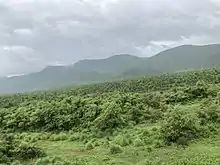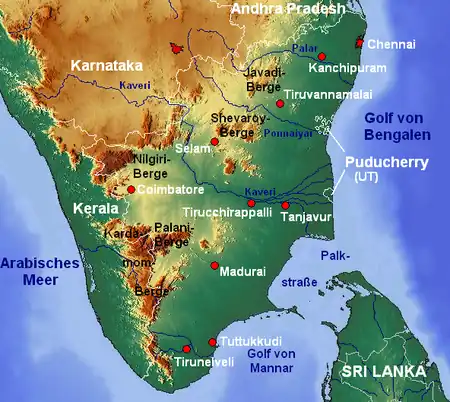| Eastern Ghats | |
|---|---|
 | |
| Highest point | |
| Peak | Sitamma Konda |
| Elevation | 1,680 m (5,510 ft)[1] |
| Prominence | 1,680 m (5,510 ft) |
| Geography | |
| Country | India |
| States | Odisha, Andhra Pradesh, Tamil Nadu, Karnataka and Telangana |
| Regions | Eastern India and South India |
| Biome | Tropical forests and Wetlands |
| Geology | |
| Type of rock | Igneous, Iron and Limestone |
The Eastern Ghats are a discontinuous range of mountains along India's eastern coast. The Eastern Ghats pass through the states of Odisha and Andhra Pradesh to Tamil Nadu by, passing parts of Karnataka and Telangana on the way. They are eroded and cut through by four major rivers of peninsular India, viz., the Mahanadi, Godavari, Krishna and Kaveri. Sitamma Konda is the highest point in both Andhra Pradesh and the Eastern Ghats at 1,680 metres (5,510 ft). The Biligiriranga Hills in Karnataka are the tallest hill range in the Eastern Ghats, with many peaks above 1500 m in height.
Geology
The Eastern Ghats are made up of charnockite, granite gneiss, khondalite, granite and quartzite rock formations. The structure of the Eastern Ghats includes thrusts and strike-slip faults along its range.[2] Limestone, bauxite and iron ore are found in Eastern Ghats hill ranges.
The Eastern Ghats are an ancient orogenic belt which formed from the collision of crustal rocks during the Archean Eon. The belt became part of the Indian subcontinent during the Gondwana period because of continental drift, making the mountains significantly older than the Western Ghats.[3]
The Eparchaean Unconformity of the Tirumala Hills is a major discontinuity of stratigraphic significance that represents an extensive period of erosion and non-deposition. It can be seen at the steep natural slopes, road scars and ravines in the Tirumala ghat roads in the Tirupati district of Andhra Pradesh.[4][5]
Hill ranges



As with the Western Ghats, the Eastern Ghats have local names along the discontinuous hill ranges.
The Ponnaiyar and Palar rivers flow from headwaters on the Kolar Plateau eastward through gaps in the Ghats to empty into the Bay of Bengal. The Javadhu Hills lie between the two rivers. There are waterfalls along remote stretches of the rivers, such as Kiliyur Falls.[6]
Madhurawada Dome in the Eastern Ghats mobile belt was formed by a tectonic arrangement with the khondalite suite and quartzite Archean rocks north of Visakhapatnam, Andhra Pradesh.[7]
The Maliya Range is located in the northern portion of the Eastern Ghats, generally ranging between elevations of 900–1,200 m. The tallest peak in this range is Mahendragiri (1,501 m).[8]
The Madugula Konda Range is also located in the northern portion of the Eastern Ghats. It is higher than the Maliyas and generally ranges between elevations of 1,100–1,400 m. Prominent summits include the highest peak of the Eastern Ghats, Arma Konda (1,690 m), along with Gali Konda (1,643 m) and Sinkram Gutta (1,620 m).[8]
The Similipal massif is considered the furthest northeast extension of the Eastern Ghats.[9]
Rivers

The Eastern Ghats are the source area for many small and medium rivers of the east coastal plains of South India.[10]
Rivers flowing through the Eastern Ghats include:
Rivers originating on the Eastern Ghats include:
Fauna
The endemic fauna of the Eastern Ghats include Jerdon's courser (Rhinoptilus bitorquatus) and the grey slender loris (Loris lydekkerianus). Rare geckos live here as well, including the Indian golden gecko (Calodactylodes aureus), granite rock gecko (Hemidactylus graniticolus) and Yercaud slender gecko (Hemiphyllodactylus aurantiacus).[11] Other endemic reptiles include Sharma's skink (Eutropis nagarjuni) and snakes such as Gower's shieldtail snake (Rhinophis goweri), Shortt's shieldtail snake (Uropeltis shorttii) and the Nagarjun Sagar racer (Platyceps bholanathi).
Mammals

Mammals found in the Easter Ghats include the Indian elephant (Elephas maximus indicus), blackbuck (Antilope cervicapra), Asian palm civet (Paradoxurus hermaphroditus), small Indian civet (Viverricula indica), Madras treeshrew (Anathana ellioti), common grey mongoose (Urva edwardsii), sambar deer (Rusa unicolor), Indian crested porcupine (Hystrix indica), Indian bison (Bos gaurus), Indian boar (Sus scrofa cristatus), common muntjac (Muntiacus muntjak), Indian leopard (Panthera pardus fusca), Bengal tiger (Panthera tigris tigris), dhole (Cuon alpinus), golden jackal (Canis aureus), Indian giant squirrel (Ratufa indica), Indian hare (Lepus nigricollis), Asian house shrew (Suncus murinus), tufted grey langur (Semnopithecus priam), Indian flying fox (Pteropus giganteus), bonnet macaque (Macaca radiata), rhesus macaque (Macaca mulatta), Bengal fox (Vulpes bengalensis), smooth-coated otter (Lutrogale perspicillata), jungle cat (Felis chaus), cheetal (Axis axis), nilgai (Boselaphus tragocamelus), Indian wolf (Canis lupus pallipes) and Indian mole-rat (Bandicota bengalensis).[12] There are about 400 tigers living in the Eastern Ghats.
Birds
A survey conducted by ATREE in the northern Eastern Ghats hill region identified more than 205 species of birds, including relatively rare ones like Brook’s flycatcher (Cyornis poliogenys) and Jerdon’s baza (Aviceda jerdoni). Threatened bird species like the Malabar pied hornbill (Anthracoceros coronatus) were also spotted in a couple of habitats.[13] Other bird species found in the Eastern Ghats include the Great Indian bustard (Ardeotis nigriceps), red-wattled lapwing (Vanellus indicus), spot-billed pelican (Pelecanus philippensis), blue peafowl (Pavo cristatus), Indian pond heron (Ardeola grayii), hoopoe (Upupa epops), spotted owlet (Athene brama), greater coucal (Centropus sinensis), pied crested cuckoo (Clamator jacobinus), Oriental white ibis (Threskiornis melanocephalus), Indian pitta (Pitta brachyura), Indian paradise flycatcher (Terpsiphone paradisi), red-vented bulbul (Pycnonotus cafer), red-whiskered bulbul (Pycnonotus jocosus), jungle babbler (Turdoides striata), painted stork (Mycteria leucocephala), black-rumped flameback (Dinopium benghalense), brahminy kite (Haliastur indus), jungle myna (Acridotheres fuscus), Indian spotted eagle (Aquila hastata), Indian vulture (Gyps indicus)[14][15] and Malabar whistling thrush (Myophonus horsfieldii).
Amphibians
Up to 30 species of amphibians live in the Eastern Ghats, including Gunther's toad (Bufo hololius), pond frogs (Euphlyctis spp.), cricket frogs (Fejervarya spp.), bull frogs (Hoplobatrachus spp.), burrowing frogs (Sphaerotheca spp.), balloon frogs (Uperodon spp.), small-mouthed frogs (Microhyla spp.) and tree frogs (Polypedates spp.). Endemic species include the golden-backed frogs (Hylarana spp.), the bush frog (Raorchestes terebrans), the recently described caecilian Gegeneophis orientalis, and an Ichthyophis species that is known only from old records.[16][17]
Reptiles
Nearly 100 species of reptiles occur in the Eastern Ghats. Many endangered species are also present, including the mugger crocodile (Crocodylus palustris), Indian black turtle (Melanochelys trijuga), Indian flapshell turtle (Lissemys punctata), Indian tent turtle (Pangshura tentoria), Indian star tortoise (Geochelone elegans) and Leith's softshell turtle (Nilssonia leithii), many of which are found in the northern rivers and riverine valley tracts.
Among the lizards present are Roux's forest calotes (Monilesaurus rouxii), Psammophilus and Sitana species, Indian chameleon (Chamaeleo zeylanicus), reticulated gecko (Hemidactylus reticulatus), rock geckoes Hemidactylus giganteus and Hemidactylus graniticolus, golden gecko (Calodactylodes aureus), slender gecko (Hemiphyllodactylus aurantiacus), rare ground geckoes Cyrtodactylus nebulosus and Cyrtodactylus collegalensis, the recently rediscovered Geckoella jeyporensis, Leschenault's snake-eye (Ophisops leschenaultii), blinking snake-eye (Ophisops minor), Ashwamedh's skink (Eutropis ashwamedhii), Beddome's skink (Eutropis beddomei), Nagarjun's skink (Eutropis nagarjuni) and Bengal monitor (Varanus bengalensis). Noteworthy lizards include endemic, fossorial species of leg-less skinks such as Sepsophis punctatus, Barkudia melanosticta and Barkudia insularis that are known only from the northern ranges and along the adjoining Eastern coastal plains in northern Andhra Pradesh and Odisha.
Among snakes present are the beaked worm snake (Grypotyphlops acutus), endemic shield-tailed snakes like Uropeltis ellioti and Uropeltis shorttii, the recently described Rhinophis goweri, the endangered Indian rock python (Python molurus), Forsten's cat snake (Boiga forsteni), yellow-green cat snake (Boiga flaviviridis), Srilankan flying snake (Chrysopelea taprobanica), Nagarjun Sagar racer (Coluber bholanathi), green keelback (Rhabdophis plumbicolor), Duméril's black-headed snake (Sibynophis subpunctatus) and Indian reed snake (Liopeltis calamaria). Apart from the Big Four Indian venomous snakes, endemic ones like Beddome's coral snake (Calliophis beddomei), Indian green Bamboo pit viper (Trimeresurus gramineus), the rare King cobra (Ophiophagus hannah) and Banded krait (Bungarus fasciatus) are also known from parts of this region.[16][17]
Protected areas
.JPG.webp)
Sanctuaries and national parks of the Eastern Ghats:
National Parks
- Bhitarkanika National Park, Odisha
- Simlipal National Park, Odisha
- Sri Venkateswara National Park, Andhra Pradesh
Wildlife Sanctuaries
- Balukhand-Konark Wildlife Sanctuary, Odisha
- Balimela Wildlife Sanctuary, Odisha
- Baisipalli Wildlife Sanctuary, Odisha
- Debrigarh Wildlife Sanctuary, Odisha
- Gahirmatha Marine Sanctuary, Odisha
- Hadgarh Wildlife Sanctuary, Odisha
- Kapilasa Wildlife Sanctuary, Odisha
- Karlapat Wildlife Sanctuary, Odisha
- Kondakameru Wildlife Sanctuary, Odisha
- Kotgarh Wildlife Sanctuary, Odisha
- Kuldiha Wildlife Sanctuary, Odisha
- Lakhari Valley Wildlife Sanctuary, Odisha
- Saptasajya Wildlife Sanctuary, Odisha
- Sunabeda Wildlife Sanctuary, Odisha
- Coringa Wildlife Sanctuary, Andhra Pradesh
- Krishna Wildlife Sanctuary, Andhra Pradesh
- Koundinya Wildlife Sanctuary, Andhra Pradesh
- Kambalakonda Wildlife Sanctuary, Andhra Pradesh
- Papikonda Wildlife Sanctuary, Andhra Pradesh
- Rollapadu Bird Sanctuary, Andhra Pradesh
- Sri Lankamalleswara Wildlife Sanctuary, Andhra Pradesh
- Cauvery Wildlife Sanctuary, Karnataka
- Cauvery North Wildlife Sanctuary, Tamil Nadu
- Vedanthangal Bird Sanctuary, Tamil Nadu
Reserves
- Nagarjunsagar-Srisailam Tiger Reserve, Andhra Pradesh and Telangana
- Satkosia Tiger Reserve, Odisha
- Sathyamangalam Tiger Reserve, Tamil Nadu
- Sunabeda Tiger Reserve, Odisha
According to a study published in 2018, the forest cover of the Eastern Ghats has shrunk drastically since 1920, and several plant species endemic to this region face the threat of extinction.[18]
See also
References
- ↑ SOI Sheet Number 65J/12, available on the Onlinemaps Portal
- ↑ Sriramadas, A. (November 1967). "Geology of Eastern Ghats in Andhra Pradesh" (PDF). Proceedings of the Indian Academy of Sciences, Section B. 66 (5): 200–205. doi:10.1007/BF03052185. S2CID 126925893.
- ↑ Eastern Ghats: an ancient orogenic, older than the Western Ghats lakesofindia.com 27 August 2022
- ↑ "Eparchaean Unconformity, Tirumala Ghat section". Geological Survey of India. Archived from the original on 19 April 2013. Retrieved 20 September 2009.
- ↑ Geological Monuments of India. Geological Survey of India. 2001. pp. 5–8.
{{cite book}}:|work=ignored (help) - ↑ "Jungle Look". The Hindu. Chennai, India. 11 February 2006. Archived from the original on 17 October 2007.
- ↑ Jagadeeswara Rao, P.; Harikrishna, P.; Srivastav, S.K.; Satyanarayana, P.V.V.; Vasu Deva Rao, B. (October 2009). "Selection of groundwater potential zones in and around Madhura wada Dome, Visakhapatnam District - A GIS approach" (PDF). J. Ind. Geophys. Union. 13 (4): 191–200. Retrieved 4 April 2014.
- 1 2 M.S. Kohli (August 2010). Mountains of India: Tourism, Adventure and Pilgrimage. Indus Publishing, 2014. pp. 36–. ISBN 978-81-7387-135-1. Retrieved 4 July 2013.
- ↑ "National Biodiversity Strategy and Action Plan profiles the Eastern Ghats of southern India" originally from http://sdnp.delhi.nic.in/nbsap/dactionp/ecoregion/eghatdraft.html%5B%5D
- ↑ T. Pullaiah; D. Muralidhara Rao (2002). Flora of Eastern Ghats : hill range of South East India. Regency Publications. p. 3. ISBN 978-81-87498-49-0.
- ↑ Basundhara Chettri; S. Bhupathy (26 July 2010). "Three little known reptile species from the Araku Valley, Eastern Ghats with notes on their distribution" (PDF). Journal of Threatened Taxa. 2 (8): 1109–1103. doi:10.11609/JoTT.o2329.1109-13. Archived from the original (PDF) on 1 November 2012. Retrieved 19 June 2013.
- ↑ No.1,2006.pdf The Eastern Ghats. Archive of No.1,2006.pdf original site
- ↑ Ganguly, Nivedita (17 July 2015). "For joy of birdwatching". The Hindu. ISSN 0971-751X. Retrieved 21 January 2020.
- ↑ Endangered vultures sighted in Raichur. The Hindu (29 August 2012). Retrieved on 28 July 2013.
- ↑ Critically endangered vulture found in Adilabad district. The Hindu (5 June 2013). Retrieved on 28 July 2013.
- 1 2 Srinivasulu, C., & Das, I. (2008). The herpetofauna of Nallamala Hills, Eastern Ghats, India: an annotated checklist, with remarks on nomenclature, taxonomy, habitat use, adaptive types and biogeography. Asiatic Herpetological Research, 11, 110-131.
- 1 2 Ganesh, S. R., & Arumugam, M. (2015). Species Richness of Montane Herpetofauna of Southern Eastern Ghats, India: A Historical Resume and a Descriptive Checklist. Russian Journal of Herpetology, 23(1), 7-24.
- ↑ Pacha, Aswathi (6 October 2018). "Eastern Ghats face loss of forest cover, endemic plants". The Hindu. ISSN 0971-751X. Retrieved 13 October 2018.










